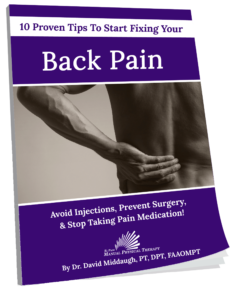TAP TO CALL (915) 503-1314

What Is A Muscle Imbalance? Lower Back Pain
Do you have a back problem? And do you think that it’s coming from a muscle imbalance in your lower back? I’m going to talk to you today all about muscle imbalances, where they begin, how they affect back problems, and what you can begin to do about it. So that the root problem, which is usually a muscle imbalance, is taken care of, and you can live a happier, healthier, more active and mobile life.
Real quick, my name is Dr. David Middaugh and I’m a manual physical therapist over at El Paso Manual Physical Therapy. I’ve been helping out people with back problems for many years. And just about every single one of them has a muscle imbalance at the root of their back problem.
Now, when they go to the doctor, when they go see their healthcare professional, they gave them a diagnosis for their back problem. They usually told that they have arthritis, a disc issue, sciatica, stenosis, other back conditions like that. Spondylosis is another one, degenerative disc disease, there are tons of back diagnosis that are given to patients, especially after they get like an MRI, or an X ray.
But those diagnoses don’t tell people what to do about it, they just kind of give it a label, but don’t really tell them why it became, how it got there. And what we find here, as specialists and helping people avoid surgery, medications and injections, is that usually the root of a back pain problem is a muscle imbalance.
And what a muscle imbalance is, if we look at the spine, the lower back, here’s the lower back, here’s your lumbar vertebrae, the lower back, there’s muscles all around here, of course, organs are in the front of the body here. But the muscles that control the move the spine, you have the muscles that go up and down the back, we call those the spinal, the paraspinal muscles or erector muscles in the name, there’s lots of different names, but they’re the ones that run up and down the sides of the spine in the back than the front, we’ve got the abdominal muscles, which connect to the rims of these bones, the rim of the ribs, and then they do send tendons all the way down to the spine. And then you’ve got hip flexor muscles, which are on the front. And they help to make bend your hip this way or flex your hip. But they do have some attachments up into the lower back.
Because all of those muscles can influence the movement and control and stability of the lower back, you have to have a proper balance between all those muscles. So that movement in the lower back is normal. When one of those muscle groups or two of those muscle groups becomes a lot stronger, or a lot weaker relative to the other muscles that stabilize back, then that’s what’s called a muscle imbalance. It’s out of balance.
And what’s going to happen as a result of that is every movement virtually every moment that that person goes through that you may be going through right now, walking, getting up out of bed standing, doing chores around the house, being active, like doing an exercise or participating in sports, playing with your family, working, all those things are done with an imbalance.
So over time, joints can start to get affected discs can start to get affected in the spine. Nerves can start to get pinched, different little things can happen. And it’s a chain reaction of events. It’s set up because of that muscle imbalance. And most people will admittedly whenever we see him here in the clinic for a back problem, they’ll say, Oh yeah, I’ve got weak abs, you might be thinking that at home already. Or Yeah, I’ve got weak hip flexors, or I’ve got tight back muscles, which is a sign that they’re over dominant.
They’ll say things like that, that expose a muscle imbalance. And a lot of times, even healthcare professionals have a hard time finding this out because they’re just not trained in it, especially if you’ve been a physical therapist. You know, I’m a physical therapist. So I know all about that that field. Most physical therapists are excellent in handling cases of patients that have just had surgery, which means you know, they just have back surgery like a fusion surgery or discectomy, or a hip or knee surgery or surgery elsewhere in the body.
Most pts just about every single one of them know how to handle that kind of situation very well. But handling muscle imbalances is a different specialty, which is something that we do very excellently and identifying it and knowing how to train it and knowing what exercises to do what exercises not to do is a big deal. Let me just be specific, if the most common back muscle imbalance that we see here are the muscles along the back.
The ones that you can just reach over to your back and feel are over dominant, so most people feel tight in those muscles. If that’s the case, then it makes sense. To avoid doing back muscle exercises. Avoid strengthening your back one of the classic exercises that is done in a physical therapy clinic is back extensions or even in gyms where they’ll lie on their stomach, and then they’ll, they’ll lean this way to tighten up these back muscles. And the thought is that if you strengthen those muscles, it’ll take the back pain away, because we have a week back.
But in reality, if there’s if you approach it from the angle of there’s an imbalance, and these muscles are dominant, that we don’t want to strengthen these anymore, we actually want to strengthen the other muscle groups, so that there’s a balance. And that’s how we take care of a problem for the long term, because it is possible to give short term relief by strengthening the back muscles, even though they’re already strong and dominant. But it’s not going to solve the long-term problem.
In fact, it’s going to feed into the root problem, which is that imbalance. So you got to watch out if you’re getting driven right now. Or if you’re looking for exercises and videos on how to fix a back problem, you’re thinking you have a weak back, you got to think twice about that and really look at your abdominal strength, kind of test it out, you might have different motions, different exercises, do some setups, do some ab exercises and see retire out quite a bit like that.
And if it’s done right, it should begin to resolve the muscle imbalance which will resolve the root problem of arthritis, the disc issue, the pinched nerve, all those symptoms that are not symptoms, all those diagnoses that are found by mainstream healthcare. What’s going on when there’s a muscle imbalance is if the muscles, let’s just use that example that the muscles on the back of the spine or two shorts, then what will happen is they if they’re too strong, they shorten, when they shorten, they compress the joints on the back of the spine, they compress the discs. And if on the low level, they’re held like that all day long as you go about your day and do your normal things.
You get wear and tear going through the back of those joints. And it’s just a matter of time before something gives. It could be the cartilage, it could be a disc, it could be a variety of things. And that’s typically what leads people to go to the doctor to go get x rays or an MRI. And then they tell them, Oh, you’ve got a pinched nerve, or you’ve got a compressed disc, or a slipped disc or a herniated disc, or you’ve got arthritis. It’s rarely ever the arthritis is fault.
It’s the muscle imbalances fault that led to the Arthritis for to the disk or to the nerve, whatever the problem was. And so, addressing that root problem is huge. It’s key. Another issue that these muscle imbalances lead to is sacral problems. So the sacrum is this bone down here, it’s the base of the spine. A lot of times we get people that come back from the doctor’s office, they’ve had an X ray, they’ve had an MRI, and they’ve been told that everything’s normal, maybe some mild changes that are kind of normal for the age of that person, nothing of concern, definitely nothing that can be operated on.
It’s so confusing for the individual because they think I can’t sleep at night, my back hurts, I’ve been over. And after doing that so many times I’m done for the day, I’m paying for it the next day, in fact, but the doctor isn’t finding anything. The surgeon doesn’t want to touch me because they think that I’m normal on my x rays and MRI, there’s nothing to operate on. Why the heck do I still have this back problem. And a lot of times, it’s because the sacrum, the tailbone is shifted, or the joints around it are stuck somehow. And that doesn’t typically show up on an X ray or an MRI. But it’s also a side effect of that muscle imbalance.
The same one that I’m talking about where muscles around here or are too weak on one side too strong on the other side, and they can yank the tailbone or these pelvis bones in different directions as well, that can produce back pain. If you’re feeling if you have if you have in that situation where your back isn’t really affected according to x rays or MRIs, but you have pain.
That means that you’ve caught it early in fixing the muscle imbalance is going to be a tremendous thing for you to do so that you can avoid it turning into an arthritis or a disc problem or some other worse condition that might have some more longer lasting effects. If you think you’ve got a muscle imbalance in your lower back, and you’re looking to get help and you think that we might be able to help you out we’d love to talk more with you.
The best thing you can do is go up to the top of our website here and find the cost and availability button. Hit that and then leave us your details. We want to hear all about your back problems so that we can see if it’s the type of problem that we can help out here in the clinic. Once you do that one of my staff will call you back so that we can hear your story and tell you the next steps on what to do about fixing your back problem naturally without surgeries, injections or medications so that you can get back to being healthy, active and mobile. I hope that we can be a part of your success story real soon. Have a wonderful day.
Would You Like To Talk With A Specialist?
Appointments and Questions Call: (915)503-1314
EL PASO MANUAL PHYSICAL THERAPY
2601 E. Yandell Drive, Suite 232
El Paso, Texas 79903
© 2023 El Paso Manual Physical Therapy, PLLC, All Rights Reserved
